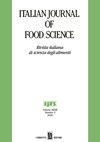两例黑色母乳与二甲胺四环素无关。鞘脂学方法
IF 3.3
4区 农林科学
Q2 FOOD SCIENCE & TECHNOLOGY
引用次数: 0
摘要
文献中报道了不同颜色的母乳(HBM),只有在米诺环素治疗过程中才会产生黑奶。我们在此报告两例未涉及米诺环素的黑/深灰色HBM。我们分析了两个牛奶样本,并将数据与两个对照HBM样本进行了比较,这两个样本取自两位母亲,她们的饮食行为和服用的补充剂(铁)与受研究的母亲相同。结果表明,黑色不是由于铁的摄入、疾病或感染引起的。苏丹红III染色是脂质的特异性染色,可见深色沉淀物。研究牛奶样品的抗氧化能力远高于对照样品。由于高水平的抗氧化剂成为促氧化剂,我们的数据表明可能存在脂质氧化。黑牛奶样品的鞘磷脂图谱显示鞘磷脂和神经酰胺积累,这可能是脂质代谢受损的迹象。结论是,补充铁不是HBM色素沉着的原因,但可能与乳腺生化机制的改变有关。根据我们的经验,深色HBM并不代表停止母乳喂养的绝对指示。本文章由计算机程序翻译,如有差异,请以英文原文为准。
Two cases of black human breast milk not related to minocycline. A sphingolipidomic approach
Different colors of human breast milk (HBM) are reported in literature, and black milk is produced only during minocycline therapy. We herein report two cases of black/dark gray color HBM without minocycline involvement. We analyzed both milk samples and compared the data with two control HBM samples taken from two mothers who had the same dietary behaviors and took the same supplements (iron) as done by the mothers under study. Results indicated that the black color was not due to iron intake, disease or infection. With Sudan III stain, specific for lipids, dark precipitates were evident. Antioxidant power was much higher in studied milk samples than in control samples. As antioxidants at high levels become pro-oxidants, our data suggested possible lipid oxidation. Sphingolipid profile of black milk samples demonstrated accumulation of sphingomyelin and ceramide, which could be a sign of impaired lipid metabolism. It was concluded that iron supplementation was not responsible for HBM pigmentation, but altered biochemical mechanisms in the mammary gland could be implicated. In our experience, dark color HBM did not represent an absolute indication for discontinuation of breastfeeding.
求助全文
通过发布文献求助,成功后即可免费获取论文全文。
去求助
来源期刊

Italian Journal of Food Science
工程技术-食品科技
CiteScore
4.20
自引率
0.00%
发文量
33
审稿时长
>36 weeks
期刊介绍:
"Italian Journal of Food Science" is an international journal publishing original, basic and applied papers, reviews, short communications, surveys and opinions on food science and technology with specific reference to the Mediterranean Region. Its expanded scope includes food production, food engineering, food management, food quality, shelf-life, consumer acceptance of foodstuffs, food safety and nutrition, energy and environmental aspects of food processing on the whole life cycle.
Reviews and surveys on specific topics relevant to the advance of the Mediterranean food industry are particularly welcome.
 求助内容:
求助内容: 应助结果提醒方式:
应助结果提醒方式:


